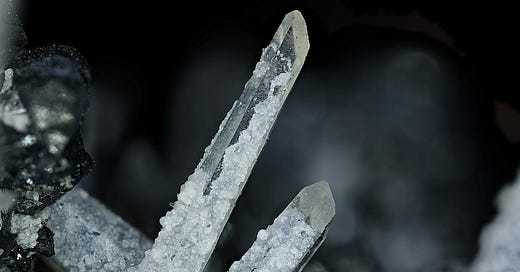I was looking through a box of minerals and came across a Sweet Home Mine tetrahedrite. There are also quartz crystals present. When I looked closer, I initially thought that they might be Tessin habit quartz (but I don’t think they are, they are more likely Dauphiné habit, having crystal tips with a single very dominant rhombohedral face).
So what is Tessin habit?
The Tessin habit is a specific crystal habit or external shape that quartz crystals can exhibit, named after the Tessin region of the Swiss Alps where such crystals are notably found. It's characterised by the strong development of rhombohedral faces and a significant reduction or even absence of prism faces.
Typical Quartz Habit: A "normal" or common quartz crystal typically shows well-developed prism faces (the six long, flat sides, denoted as 'm' faces) forming the main body of the crystal. These are then capped by rhombohedral faces (typically three 'r' faces and three 'z' faces) which form the pointed terminations.
Tessin Habit Characteristics: In Tessin habit, the rhombohedral faces (r and z) are exceptionally well-developed and often very steep. The m-faces (prism faces) are either very short, appearing almost as lines between the rhombohedral faces, or they are entirely absent.
This results in a crystal that can look like a bipyramid (two pyramids joined at their bases) if both positive (r) and negative (z) rhombohedra are equally developed, often with no visible prism body, or like a very short, stout prism capped by very large, steep rhombohedral terminations.
When the positive (r) and negative (z) rhombohedral faces are equally developed, the termination can appear to have hexagonal symmetry, even though quartz is fundamentally trigonal.
Tessin habit is generally associated with specific geological environments, typically high-temperature and relatively low-pressure conditions. It is often found in alpine-type fissures or veins, which experience these conditions during their formation. Rapid growth can also favour this habit.
In essence, imagine a typical six-sided quartz crystal. Now, "shrink" the six long body faces until they are very small or disappear, and "enlarge" the pointy cap faces until they dominate the crystal's shape. That gives you a good idea of the Tessin habit. 😁
And what is Dauphiné habit?
The Dauphiné habit (named after the Dauphiné region in the French Alps) refers to a specific morphological characteristic of quartz crystals, primarily concerning the unequal development of equivalent rhombohedral faces at a termination.
Typical Quartz Termination: A "normal" quartz crystal termination is formed by six rhombohedral faces. These consist of three faces of the positive rhombohedron (typically labeled 'r' faces) alternating with three faces of the negative rhombohedron (typically labeled 'z' faces). Ideally, all six faces are of similar size, giving the termination a pseudo-hexagonal (six-sided) appearance.
Dauphiné Habit Characteristics: In the Dauphiné habit, at one (or both) terminations, three of these six rhombohedral faces become significantly larger than the other alternating three. This means either the three 'r' faces will be dominant and the 'z' faces very small (or vice versa), or one set of faces will be largely developed while the other is almost or completely suppressed.
Appearance: The termination loses its pseudo-hexagonal symmetry and instead appears distinctly trigonal (three-sided). The crystal cap looks like a three-faced pyramid rather than a six-faced one. If prism faces ('m' faces) are present, the crystal can sometimes appear slightly twisted or asymmetrically developed towards the termination due to this habit.
Not about Prism vs. Rhombohedron Ratio: Unlike Tessin habit (which is about the dominance of rhombohedral faces over prism faces), Dauphiné habit is specifically about the relative development within the set of rhombohedral faces themselves. A crystal can have well-developed prism faces and still show Dauphiné habit at its terminations.
Formation Conditions: The specific conditions favoring Dauphiné habit are less rigidly defined than Tessin habit. It can be influenced by the presence of Dauphiné twin boundaries, variations in growth rate, or the chemical environment (presence of certain impurities). Temperature and pressure can play a role, but it's not as strongly linked to specific high-T, low-P alpine-type conditions as Tessin habit.
In essence, while a typical quartz point looks like a six-sided pyramid, a quartz crystal with Dauphiné habit will have a termination that looks more like a three-sided pyramid because three of the alternating cap faces are much larger than the other three. That gives you a good idea of the Dauphiné habit. 😁
Below: Tetrahedrite, Quartz, Pyrite, Sweet Home Mine, Mount Bross, Alma Mining District, Park County, Colorado, USA. Width of view 9mm.





exc. presentation; tnx!
Can’t seem to get ‘ like’ ikon, but like article.